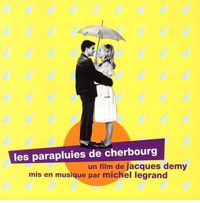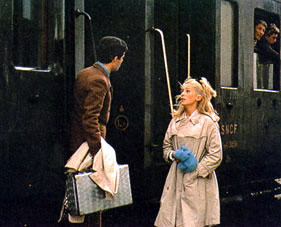When was the last time you saw a French cinema classic? Try Jacques Demy's Les Parapluies de Cherbourg (1964), one of the most beautiful and captivating romantic films ever made, a monument to ruined happiness and devastated hopes.
The Umbrellas of Cherbourg, Demy's valentine to the classic Hollywood musical, is an experimental film about love and loss and at the same time a symphony of colour and music that you either hate or will make your heart sing. Demy creates a dream world where love and regret are as real as sunshine and raindrops, and where everyday settings and events are portrayed with lyrical eloquence.
The film is a musical in the truest sense of the word - but very different from the conventional stage form. In an opera or a modern stage musical, the music is the dominant component of the artistic ensemble - often carrying much greater weight than the dialogue and the visuals.  In Les Parapluies de Cherbourg, the music is there to support the dialogue, to amplify its power of expression - to guide our emotional response, not to create it. Demy once noted that the film should be described as a film "in song" the way that some films are "in colour." Our feelings are aroused by the images we see, the sad, tragic faces of the separated lovers, reinforced by the simple, but eloquent dialogue, and finally echoed by the subtle, but emotionally charged music. Jacques Demy, a greater innovator of the French New Wave, created a new art form, and one that has never been successfully imitated. The story is a simple one, fitting the traditional operatic form of unrequited love and dramatic irony - ostensibly a bad choice for a conventional film. Fortunately, Demy's film defies conventions and, here, it is the naïve simplicity of the story, which gives the film its authenticity and emotional impact. True, it takes a while to get used to the film's unusual style - the opening scene with burly mechanics singing about their plans for the evening feels distinctly unsettling. But, as the film progresses, the musical form seems to fit perfectly. In Les Parapluies de Cherbourg, the music is there to support the dialogue, to amplify its power of expression - to guide our emotional response, not to create it. Demy once noted that the film should be described as a film "in song" the way that some films are "in colour." Our feelings are aroused by the images we see, the sad, tragic faces of the separated lovers, reinforced by the simple, but eloquent dialogue, and finally echoed by the subtle, but emotionally charged music. Jacques Demy, a greater innovator of the French New Wave, created a new art form, and one that has never been successfully imitated. The story is a simple one, fitting the traditional operatic form of unrequited love and dramatic irony - ostensibly a bad choice for a conventional film. Fortunately, Demy's film defies conventions and, here, it is the naïve simplicity of the story, which gives the film its authenticity and emotional impact. True, it takes a while to get used to the film's unusual style - the opening scene with burly mechanics singing about their plans for the evening feels distinctly unsettling. But, as the film progresses, the musical form seems to fit perfectly.
It is a visually stunning musical tale told in three acts: Departure, Absence, and Return. Geneviève (Catherine Deneuve) is the daughter of an umbrella shop owner who falls in love with Guy (Nino Castelnuovo), a garage mechanic. Despite her mother's (Anne Vernon) objections, they decide to marry. However, their plans are disrupted when Guy is drafted to Algeria. In a poignant cafe scene, the young lovers decide to postpone their marriage until after his tour of duty (the haunting score of I Will Wait for You). But Guy's absence soon proves unbearable for the young, confused Genevieve, and begins to doubt his love: "Why is Guy fading away from me?" Demy's revolutionary use of vibrant colour is a strong departure from the highly stylised black and white films of the French nouvelle vague. Michel Legrand's compositions are more characteristically fused from jazz and opera than structured from traditional Hollywood musicals. Jacques Demy pays loving homage to the Hollywood musical as well as the French melodrama.

The film is shot in Cherbourg, France, using inventive cinematography and blazing colours and textures. Local life is rendered in pink, orange, green, and blue. Wallpapers and umbrella patterns, sweaters and hats, cars and gas stations--each element of the film contributes to the exuberant colour and exalted mood. Colour also reflects mood--the deep red of the dance halls and brothels, the confused and lonely patches of lime green and pink outside of Guy's apartment that Demy cuts to in the lovers' confusion, and the vibrant orange we see as Guy's life takes a turn for the better later in the film are just a few examples. Night and day are also effective metaphors, as Genevieve and Guy only manage to meet each other outside the light of Genevieve's disapproving mother (an idea that's reinforced later when Genevieve walks the same paths she took with Guy, this time with a different man).
The film is also unique in the sense that every word is sung. The fertile collaboration between Demy and legendary French composer Michel Legrand reaches its climax in the light opera structure and lilting and memorable songs that make up the plot The story has distinct elements of neo-realism It is an exhilaratingly beautiful narrative of a contemporary love story.
While writing the film, Demy and Legrand marked "hankies" on the score, places where they knew the audience would respond most intensely, and they certainly saved their best hanky for last. There is a long-overdue reunion between Guy and Geneviève in the final scene of their film, and their magnanimity and grace gives the film a bittersweet finish without being preachy, mean, or false. And that is something, which few films, musical or otherwise, can say for themselves. Not to forget Catherine Deneuve, who is so young, so innocent, so lovely, it's enough to break your heart.
|
